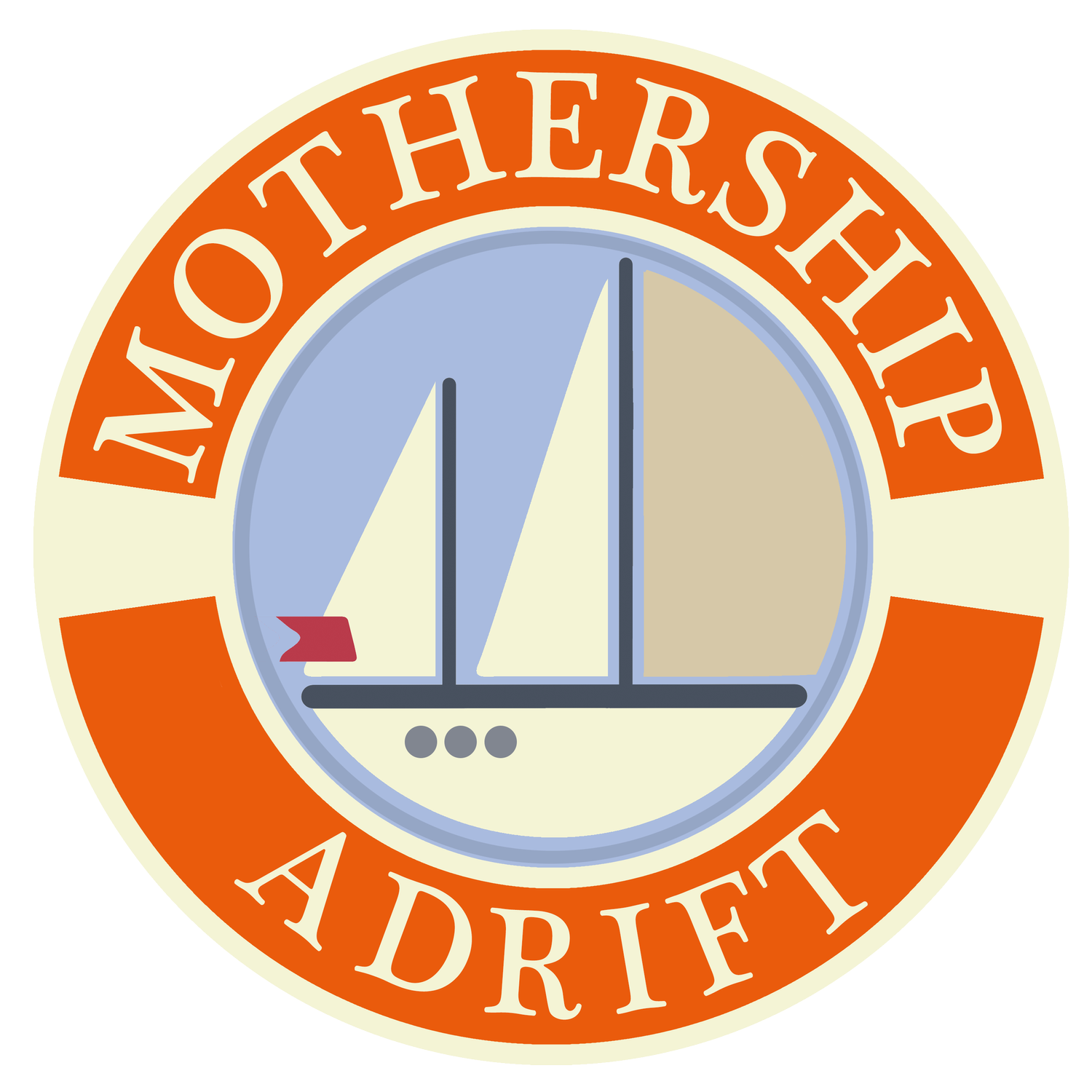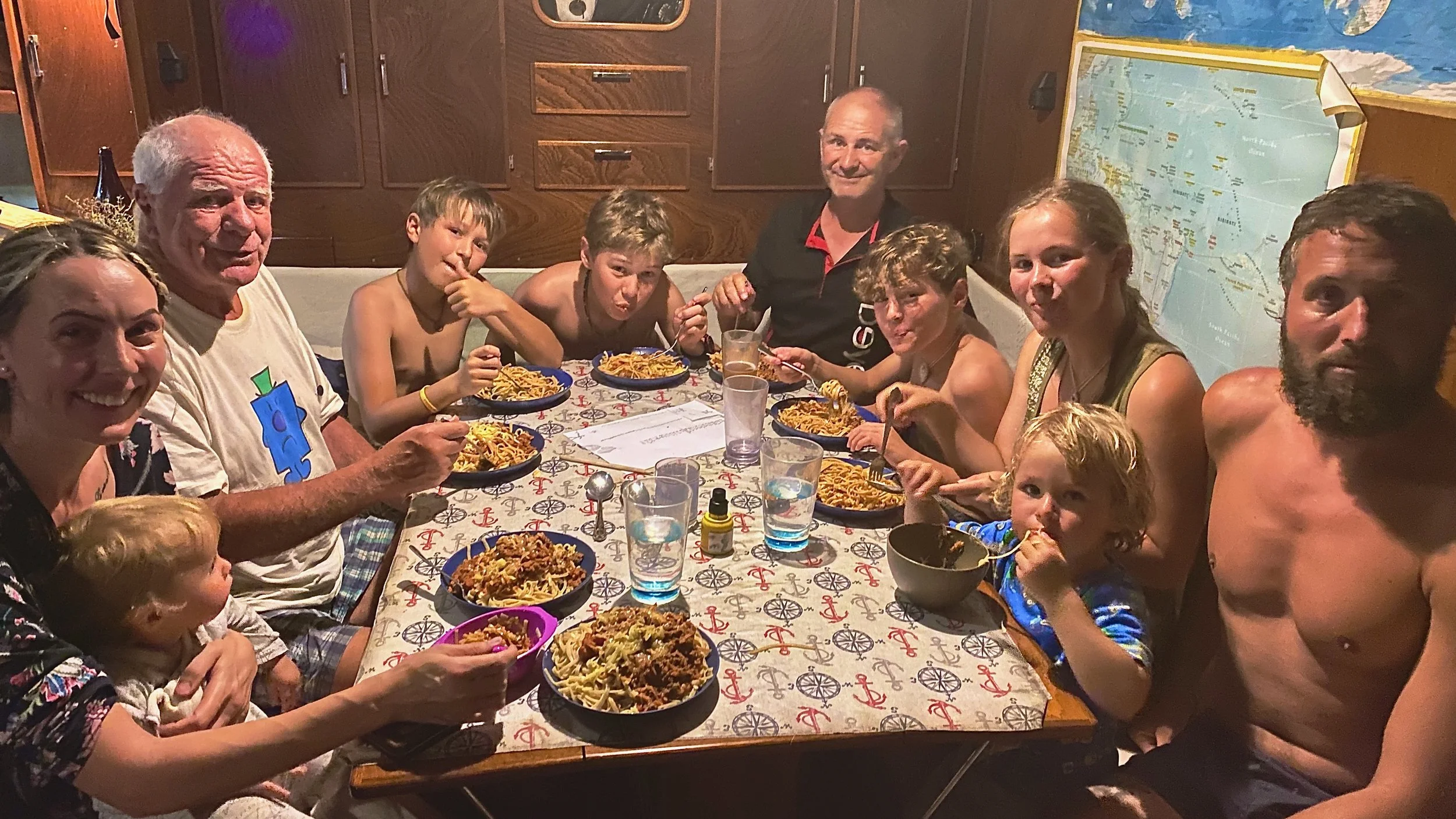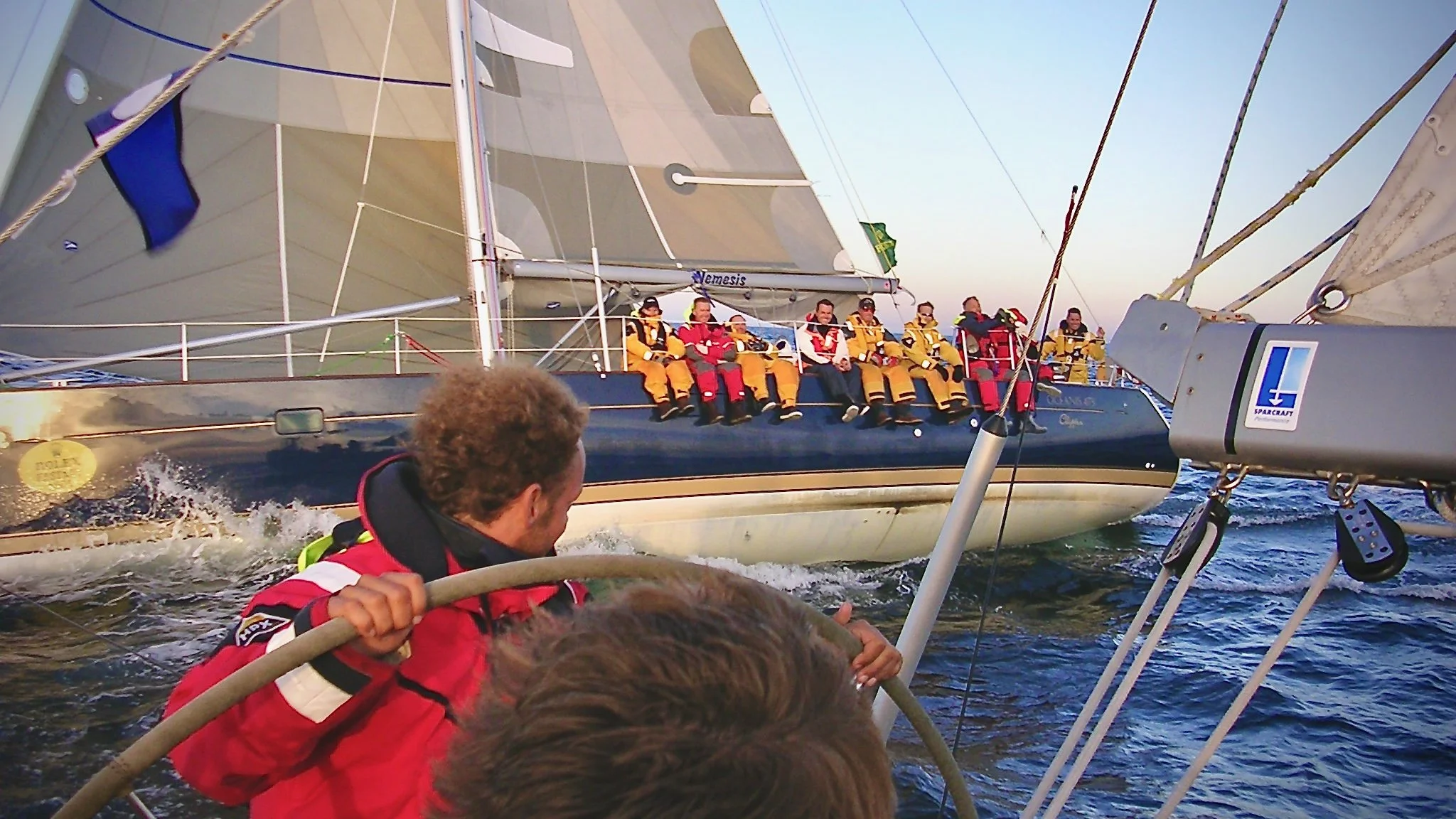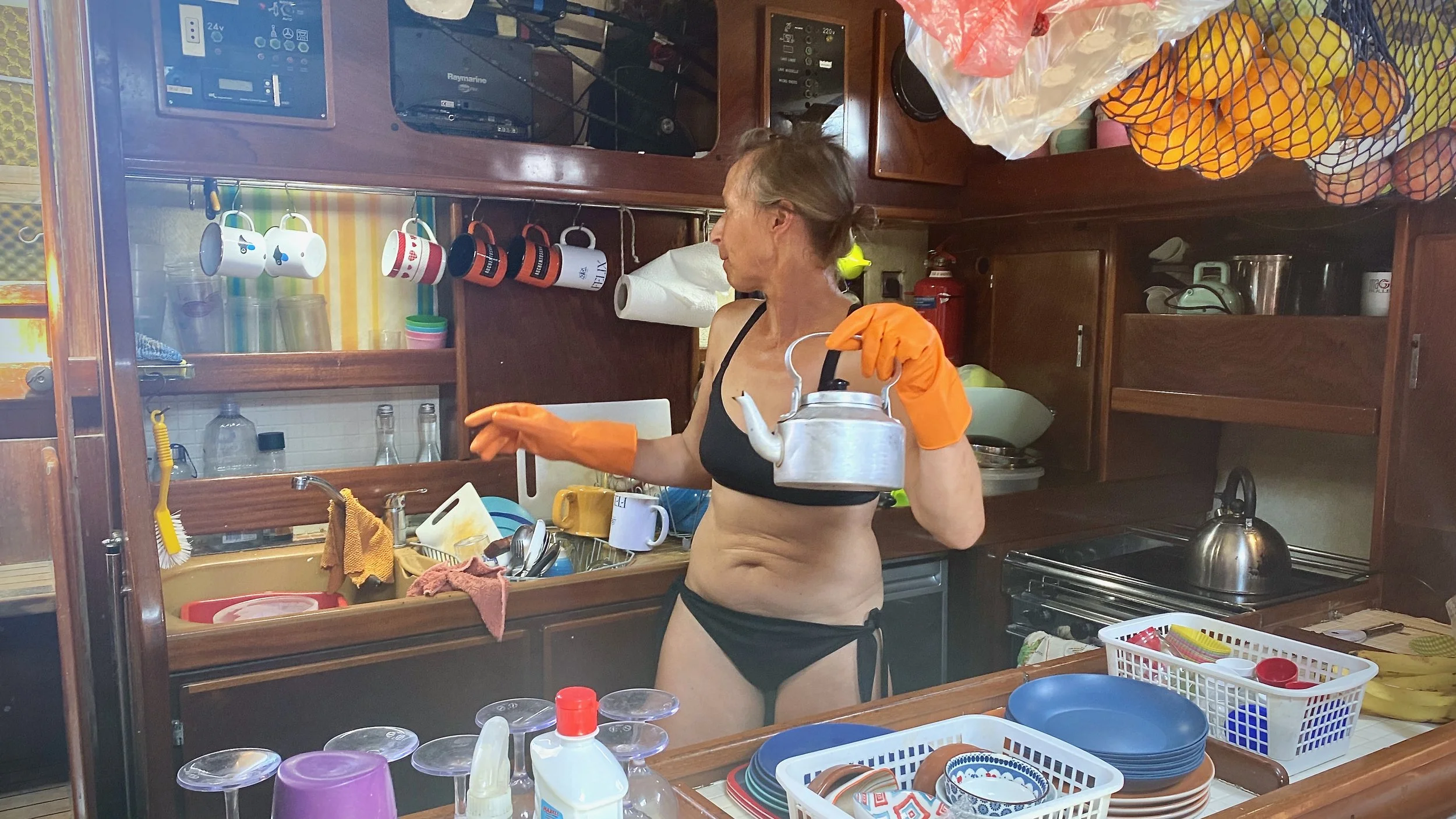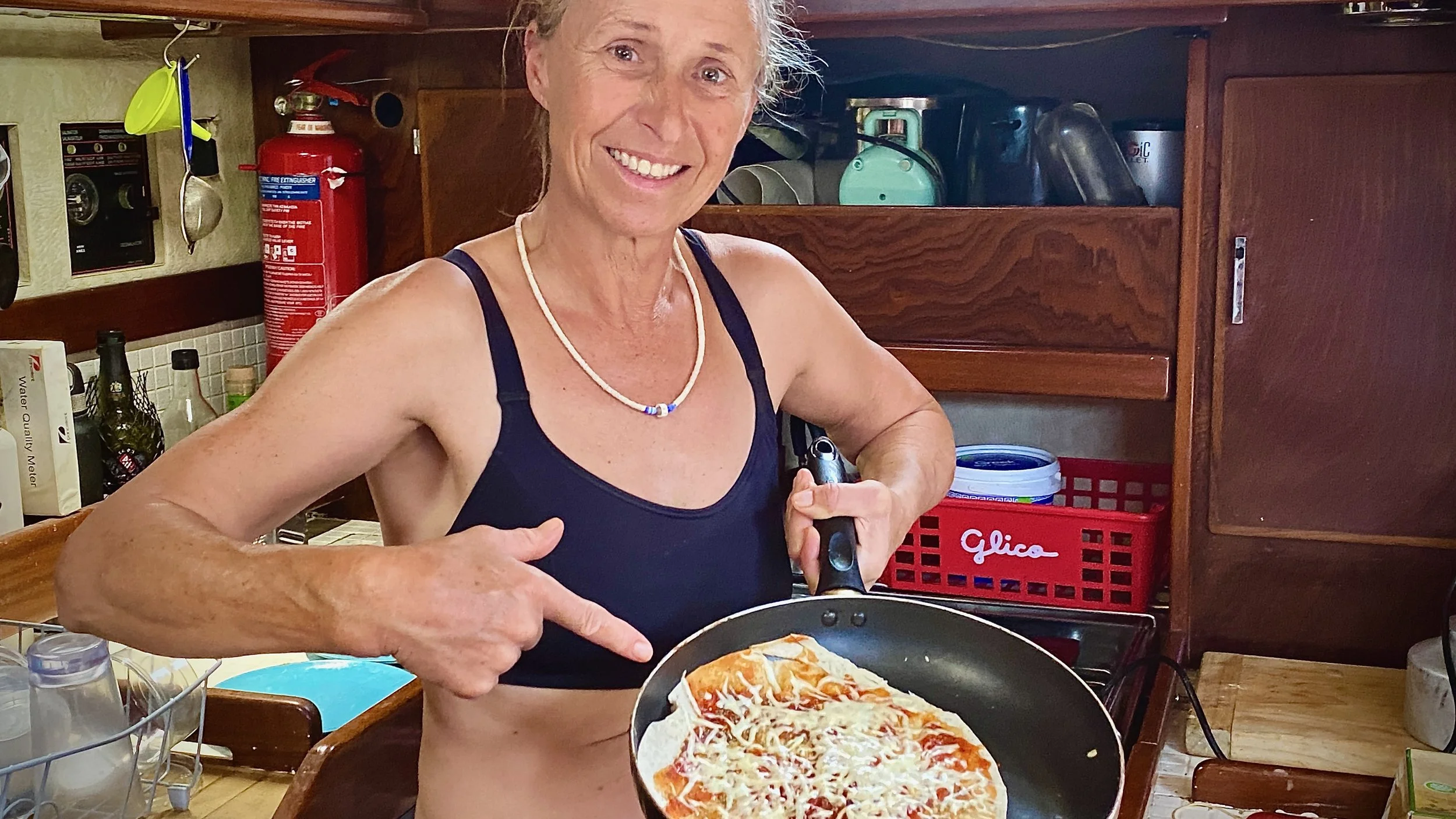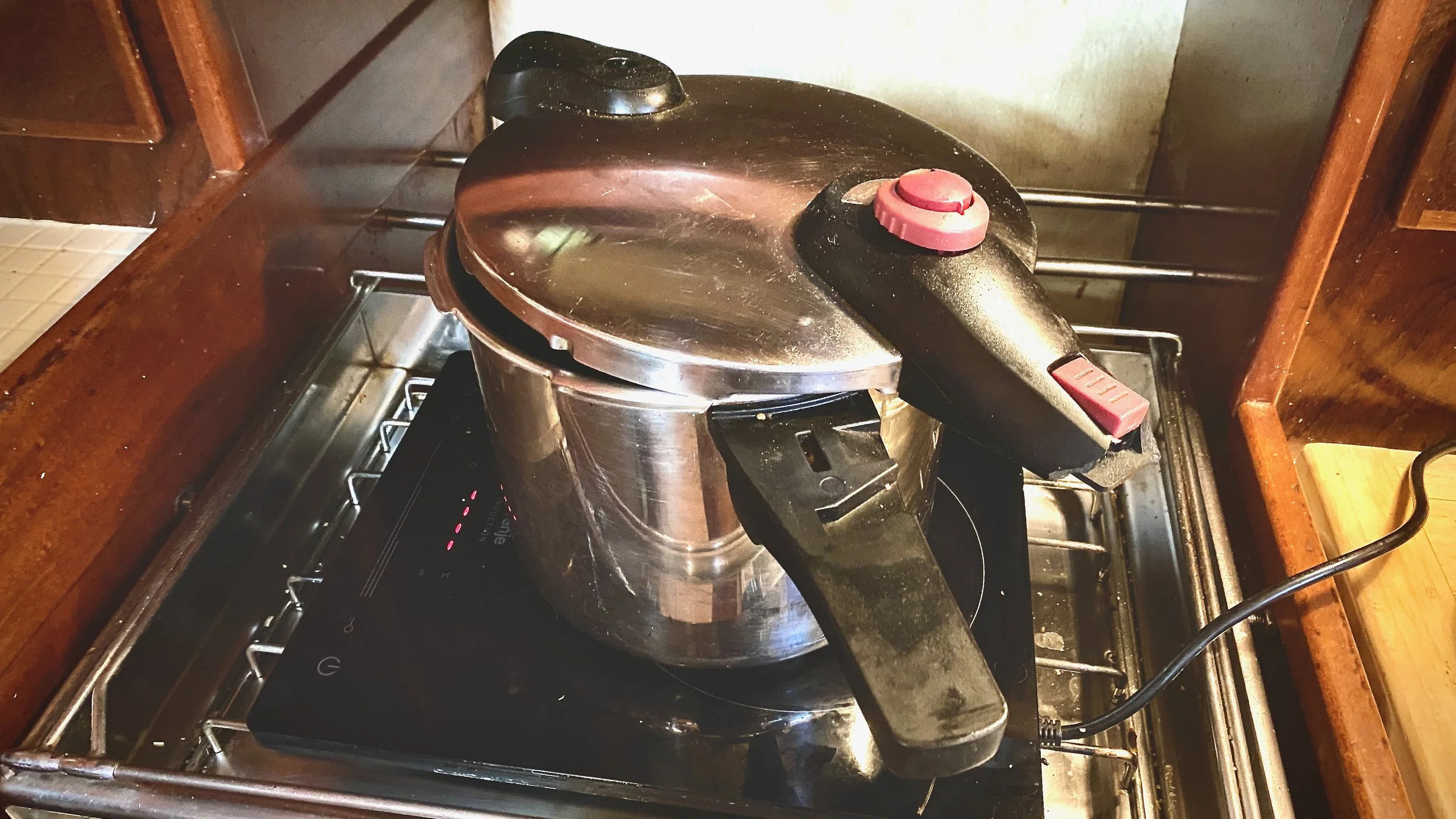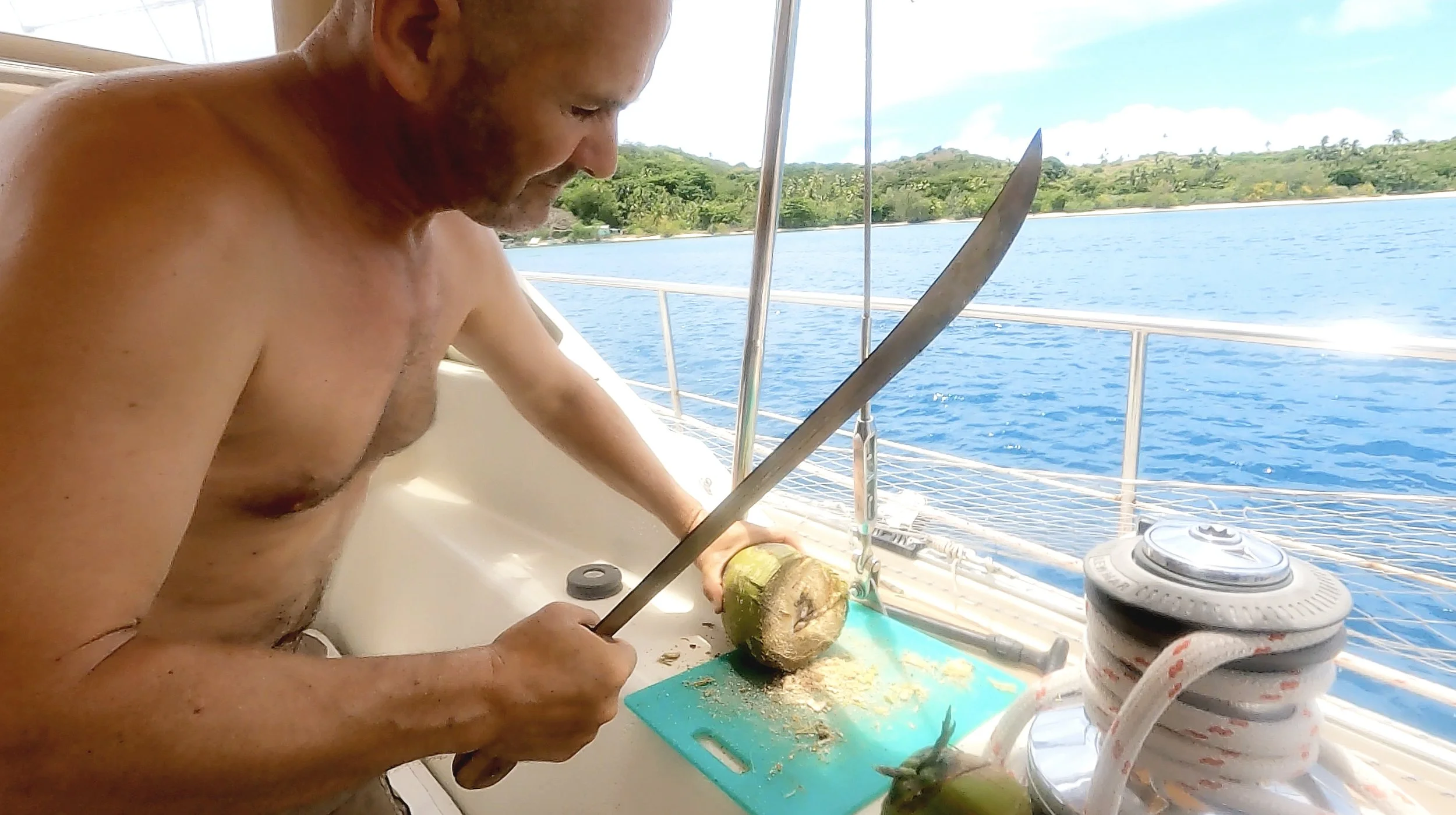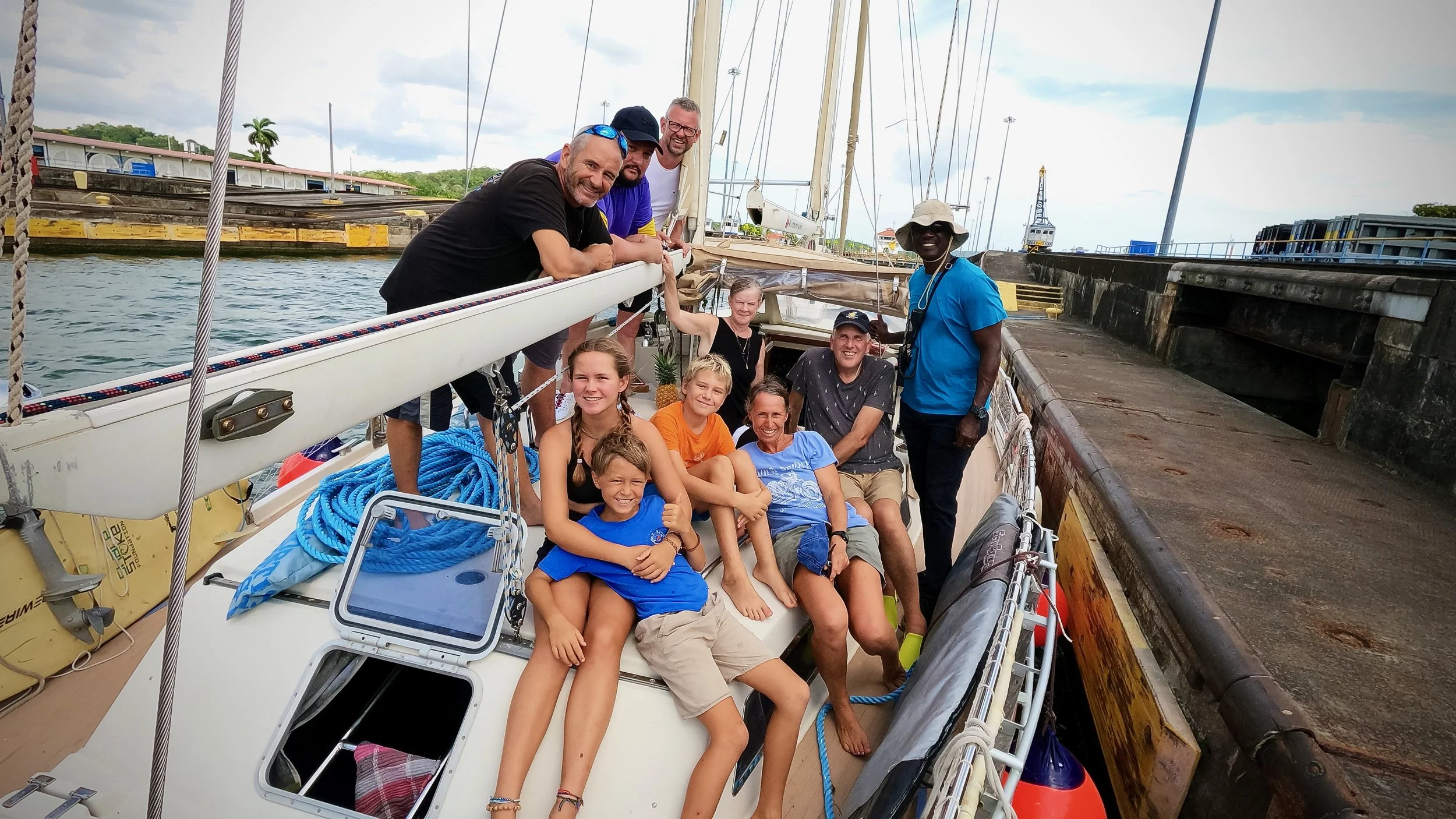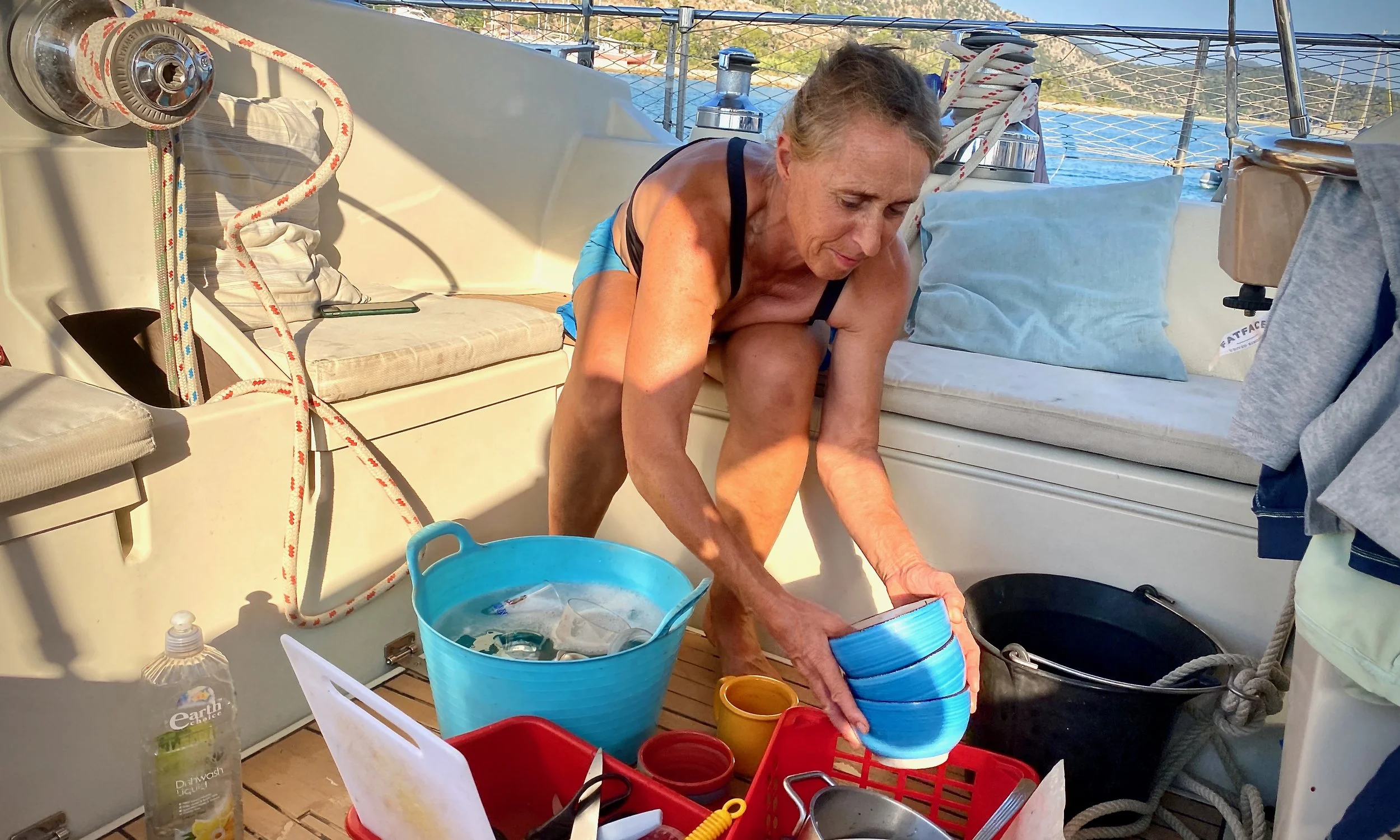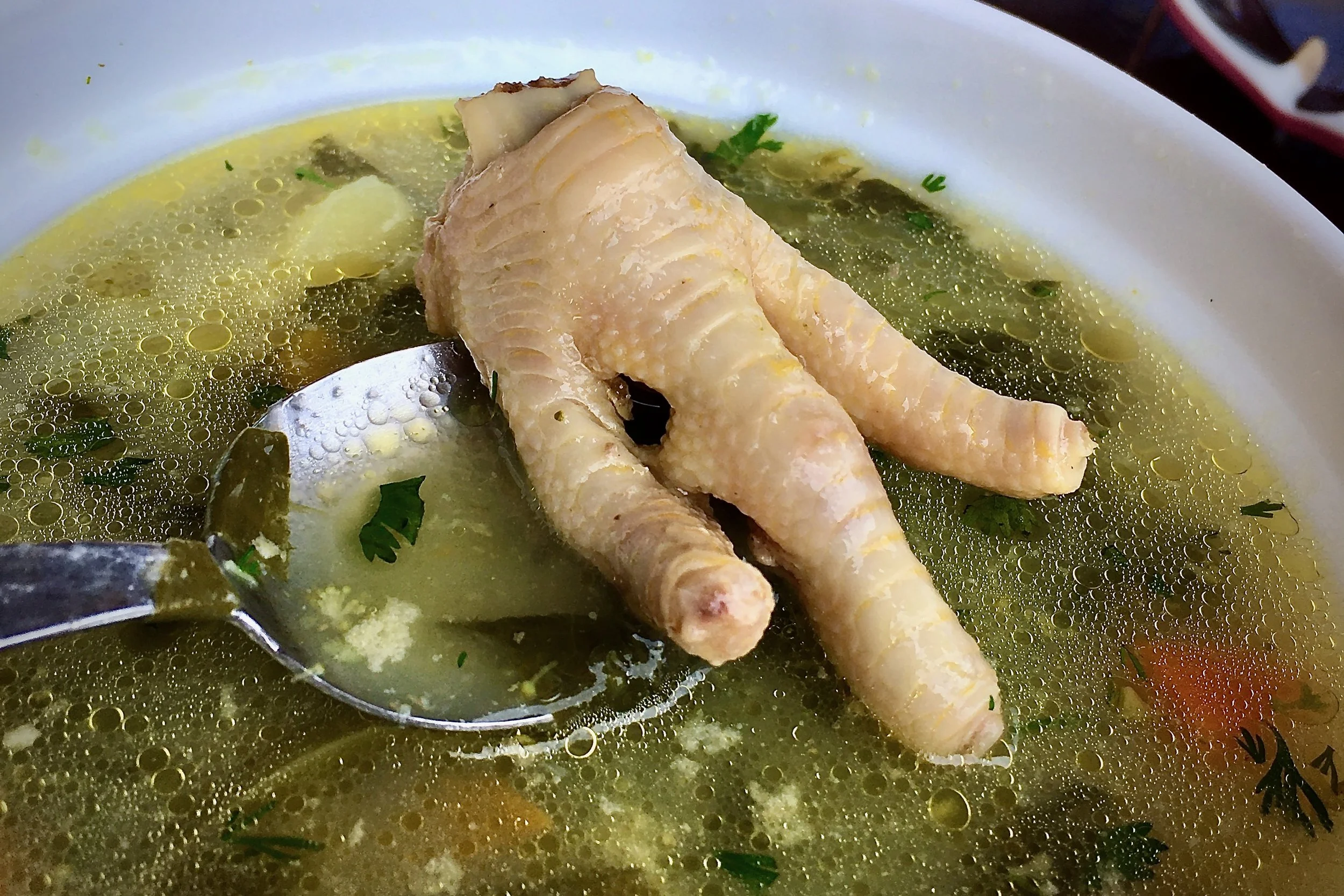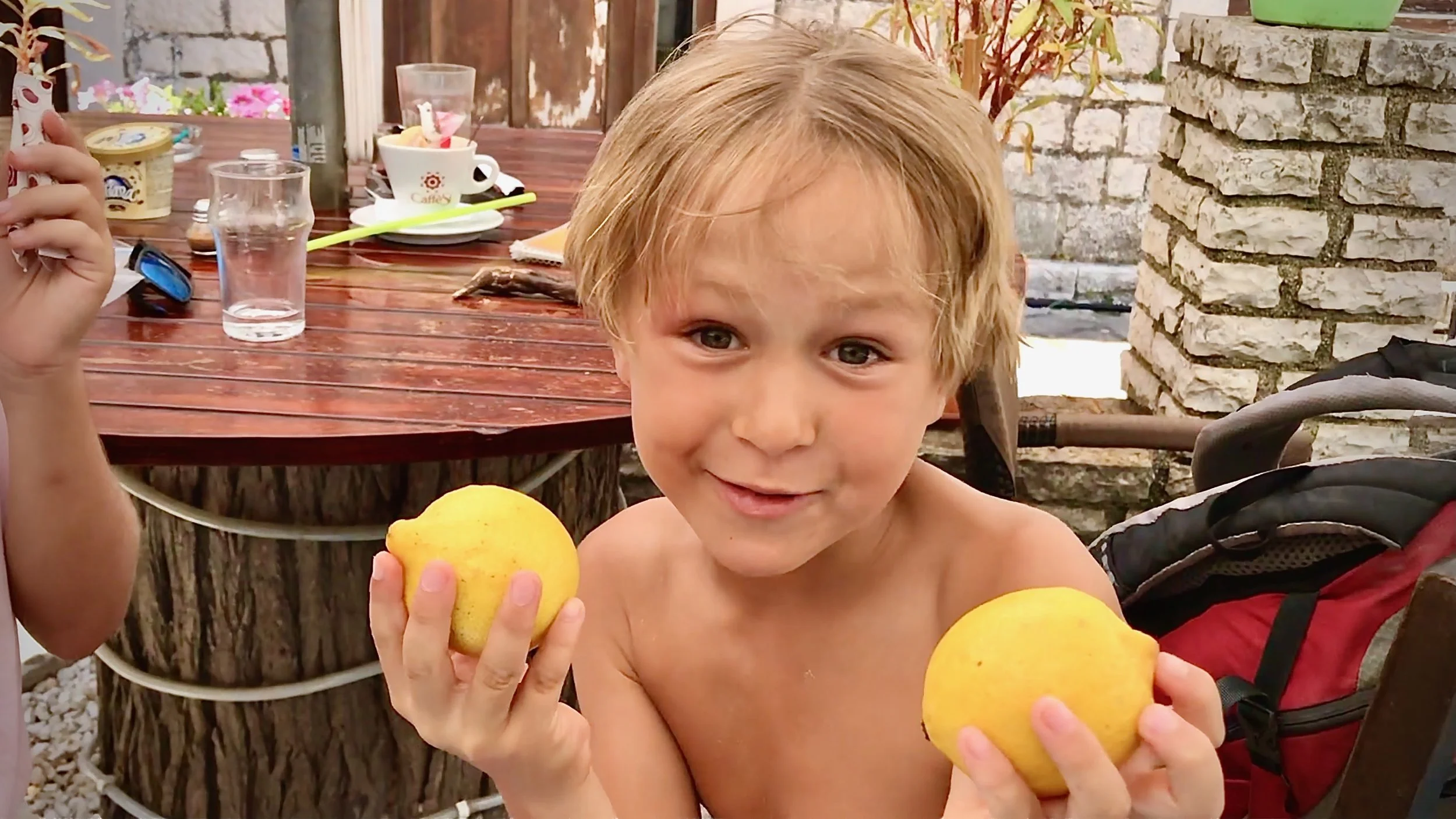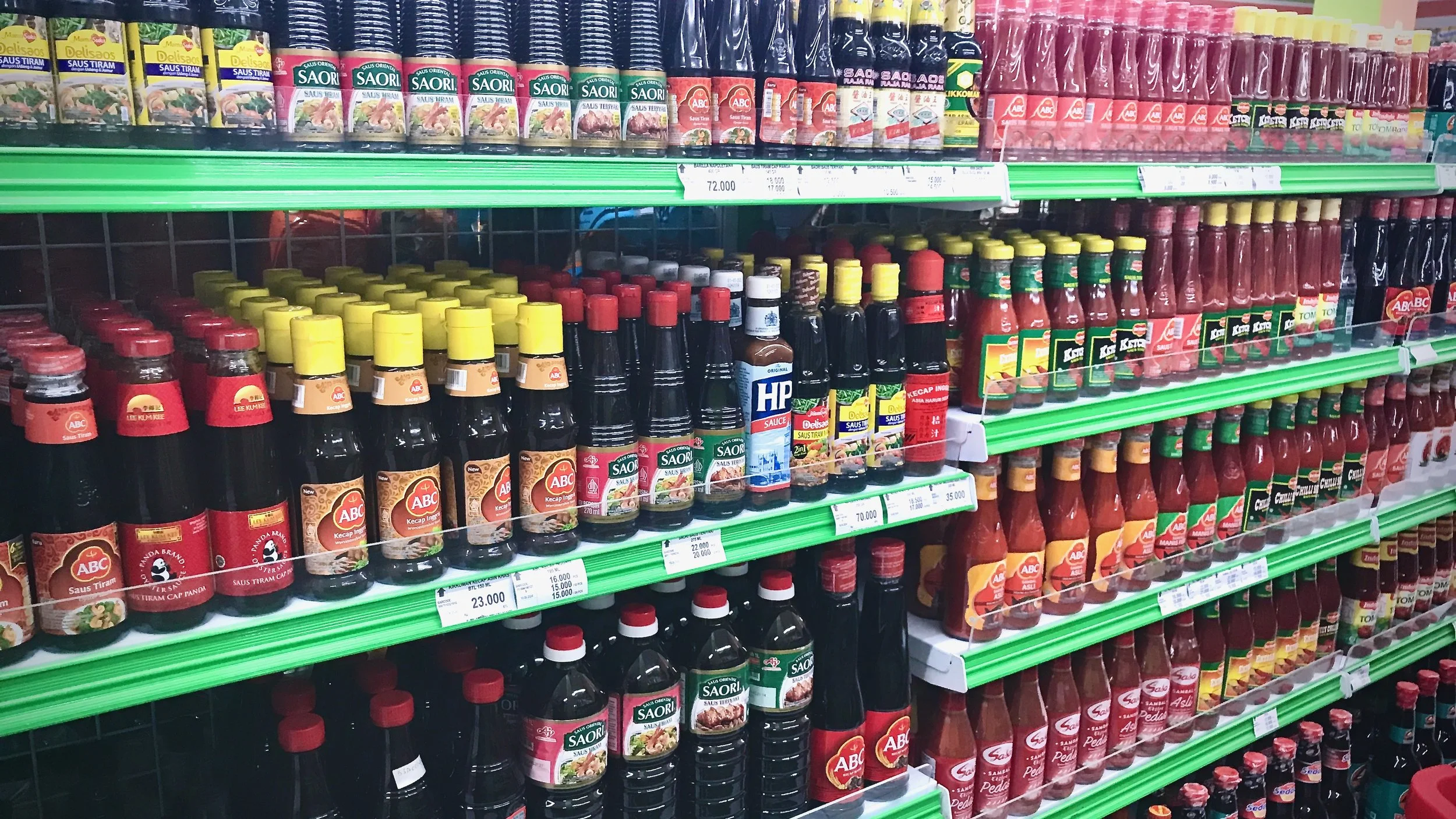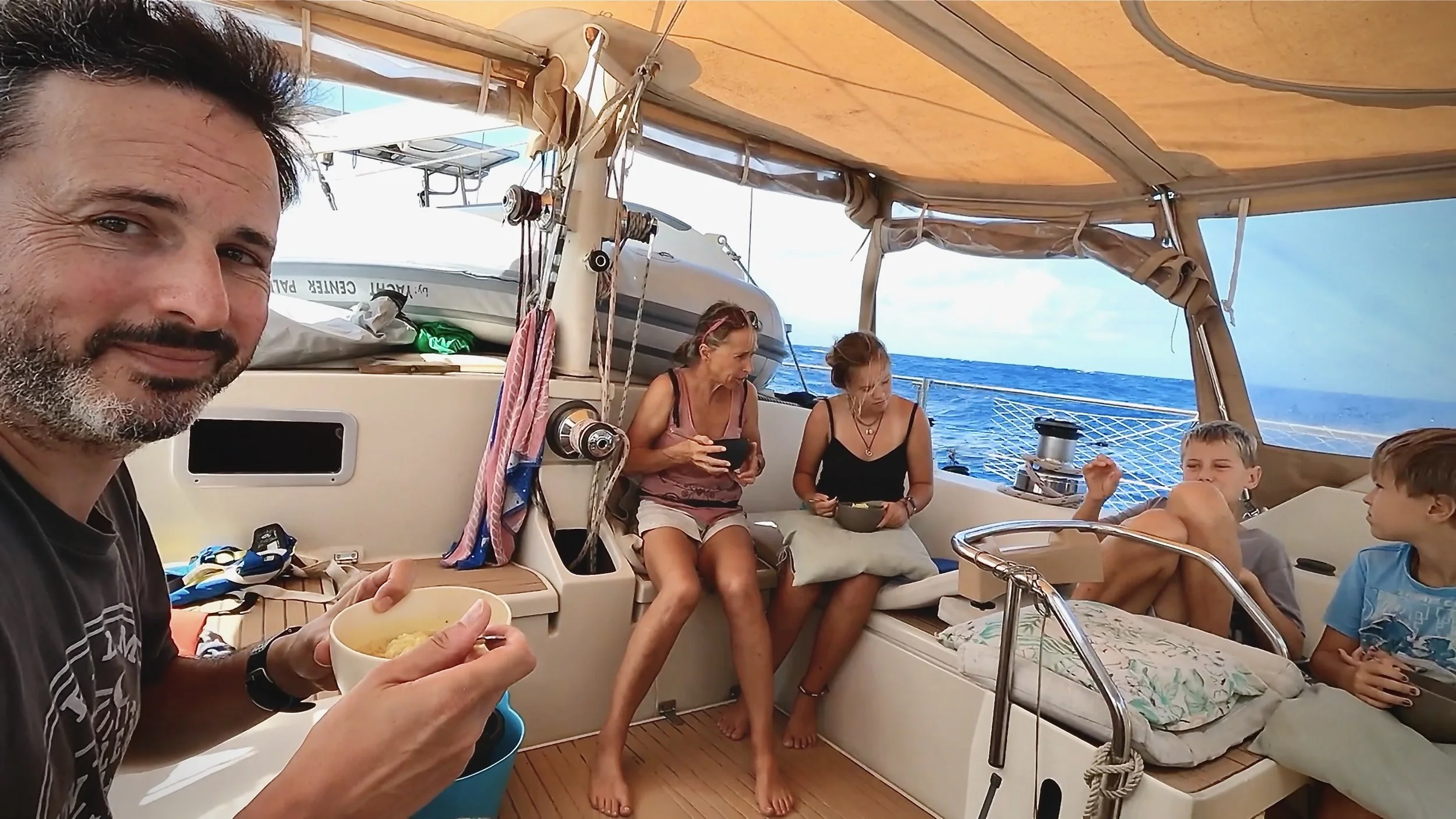Cooking on a Sailboat at Sea
01-04-11
“Good food is very often, even most often, simple food.”
Having the family around for dinner on S/V Mothership is quite a challenge!
At Sea, Food is Everything
The Fastnet Race is a round trip from the UK’s south coast to the south coast of Ireland that usually takes about four or five days. In 2005, we had a pan-European crew: Czech, Swedish, French, Spanish and British. The rivalry over food had already begun during the qualifiers, so instead of doing what most racing boats do, i.e. resigning ourselves to pot noodles and despair, I handed out a handful of aluminium containers and told the more culinarily inclined to fill them with their best home-cooked recipe. Contents were kept secret, except for the crucial intel: beef, pork, chicken or vegetarian. That way, I could stack them in order without triggering a food-based international incident. We had no freezer, you see.
Each mealtime, with zero prep and maximum efficiency, we chucked the containers in the oven. Half an hour later, we’d be sat on the gunwale or slouched in the cockpit, wolfing down hot, home-cooked national delicacies and rating each other’s efforts, which were, frankly, impressive.
The Fastnet Race - a round trip from the UK’s south coast to the south coast of Ireland -usually takes about four or five days.
Dinner became the highlight of the day and spirits were high. If there was a prize for the best-fed crew and high morale, we would have stomped to victory! But the winds were particularly light that year, the race dragged on, and eventually, we ran out of gourmet fortification. Out came the budget-brand emergency pizzas I’d stashed in the bilge. On that final day, morale nosedived, tempers flared, and most of the pizza ended up in the sea, along with what remained of our good humour.
Now, I’m not saying food is everything… but at sea, it sort of is. It’s often the only time the crew stops swearing and sits down together like semi-functioning humans.
As Mr Midshipman Hornblower said, “the men could forgive storms and shot, but not poor rations.”
Heroes Wear Aprons
In the Golden Age of Piracy (if you can refer to it as that), cooks were sometimes spared or even recruited because every captain knows a proper meal fuels the body, lifts the mood, and importantly at sea, marks the rhythm of the day.
Anyone who can rustle up a feast from a can of corned beef and a jar of pickled gherkins on a rough passage takes on a God-like stature. A sailboat on the ocean is a small world where heroes don’t wear capes - they wear aprons.
The Magic of One-Pot Wonders and Prep
Fresh, clean food isn’t just about the health of the crew and not dying of food poisoning, it keeps morale up too, not just in the eating, but in the self-sufficient process of creating it.
For instance:
Sourdough baking (no yeast needed)
Yoghurt-making (with UHT or powdered milk)
Sprouting (for fresh greens on long passages)
Rainwater catching (when dock water is dodgy, or your water maker’s on strike again)
Cooking onboard is rarely elegant. But anyone who can rustle up a feast from a can of corned beef and a jar of pickled gherkins takes on a God-like stature.
But cooking onboard is rarely elegant. It’s part ingenuity, part acrobatics, and mostly blind optimism. On Mothership, there’s been rationing. There’s been blood. There’s been tears. There’s been shouting.
Lots of shouting.
So, forget elaborate cuisine. When the wind’s up and the sea’s confused, the holy grail is the One Pot Wonder. Stews, soups, and pasta dishes that can all go in the same pan and be ladled out with one hand while you cling to the galley tap with the other. Recipes that can be easily eaten from a bowl in the cockpit while on the move.
We have wedged our arses against the fridge at 20 degrees of heel, wrestling with the pressure cooker more times than I care to remember. But no matter where we placed that thing, it would always Houdini itself free mid-passage and go careening around the galley like a wrecking ball.
'Lunch Pizza’ - a thin tortilla base, dry fried in a pan on the induction hob with a topping of puréed tomatoes, cheese and sprinkled with anything vaguely edible.
On long ocean passages we lived for weeks off bolognese, pasta, tinned curry, and something we optimistically called ‘lunch pizza’ - a thin tortilla base, dry fried in a pan on the induction hob with a topping of puréed tomatoes, cheese and sprinkled with anything convenient and vaguely edible to add variety. Dessert was often a piece of fruit, a biscuit and a rationed square of chocolate with a muttering of complaints.
One of our favourite gadgets was a waffle maker which, besides making traditional waffles, was great for repurposing potatoes and rice. It also meant we could offer something a little different with similar ingredients when meals got to feel a bit ‘samey’. You could pre-cook them before a passage then just pop them in the toaster to reheat and eat without utensils. That was before it was taken out by that bloody pressure cooker along with the halogen cooker, microwave and smoothie maker. I honestly don’t know why we kept that thing. It was the proverbial cuckoo in the nest of galley equipment.
One Pot Wonders: Stews, soups, and pasta dishes that can all go in the same pan and be ladled out with one hand. But our pressure cooker proved to be very destructive!
Before setting off on a long passage, consider pre-cooking easily digestible and easily reheated meals to cover the first few days. It massively reduces waste and prep time at sea. It’s difficult to gauge the appetites of crew in the first few days, especially after being ashore for a while. This means crew can dip in and eat as much or as little as they want and it won’t spoil easily if not all eaten at once. We generally go for bolognese, hearty soups and even pre-cook bacon and sausages that can be reheated and put in a sandwich or eaten cold as finger food.
If, like us, you also love a fresh fruit smoothie, consider making up small ‘smoothie bags’ of frozen fruit to store in the freezer. You can discard the peelings before heading off, it uses far less space than storing whole fruit and requires far less prep time. You can also rejig the recipe with whatever local fruit you buy, exchange or shake out of a tree when you do hit land.
Consider making up a ‘smoothie bags’ of frozen fruit then rejig the recipe with whatever local fruit you can shake out of a tree when you do hit land. Fiji
Cleanliness, Hygiene and Safety
Food safety at sea isn’t optional. A dodgy tuna salad when you’re 500 miles offshore is not an inconvenience, it’s a potentially explosive problem in a very small space. We developed a healthy paranoia about mayonnaise after a crew member contracted salmonella from a potluck pasta salad right before transiting the Panama Canal. And remember, when one crew member is in their sick bed, the rest of the crew have to pick up the slack in terms of night watches and other duties. So it’s not just about hygiene. Fatigue in the rest of the crew can have a serious knock-on effect on boat safety.
A crew member contracted salmonella from a potluck pasta salad right before transiting the Panama Canal - Panama Canal.
One hand stirs, while the other braces, so hand washing and surface cleaning takes on a whole new level of importance. If water is scarce, use alcohol gels or wipes often. Don’t use that chopping board you prepped the chicken on to cut the pineapple either. Separate those boards. Boil water for washing up if the hot water system isn’t hot enough. We generally do a saltwater rinse to remove food before the proper wash to save water.
No cold rice. No shellfish unless you’re very sure, and always crack the eggs into a separate bowl before you use them. Always be acutely aware of food allergies with new and unfamiliar crew. The last thing you want to be dealing with mid-ocean or remote anchorage is anaphylactic shock.
We generally do a saltwater rinse to remove food before the proper wash to save water. Cephalonia, Greece
Galley hygiene is no different to kitchen hygiene, it’s just that in a galley you tend to stand inside the food mixer and add a tablespoon of paranoia to every mealtime.
Meal Prep: The Ultimate Defence
At the risk of sounding all Jamie Oliver, with a bit of imagination and a splash of ingenuity, you really can turn base ingredients and battered old kit into something varied, satisfying… even exciting. Limp carrots become the base of a rustic stew or soup, stale bread turns into croutons or bread crumbs for schnitzel. It’s not about luxury, it’s about reframing the ordinary into the exotic. Shift the perspective, and the silence around the cockpit as the sun goes down at mealtimes becomes pure gold.
A bit of imagination and a splash of ingenuity, you really can turn base ingredients into something varied, satisfying - like this coconut bread made with fresh coconuts - Fiji.
Presentation helps. People eat with their eyes and ears before anything touches their tongue, so give it a fancy name and serve it with confidence. The crew (and by crew, I mostly mean the kids) are far more likely to buy in. That’s culinary alchemy right there: perception over perfection.
A bit of humour goes a long way, too. After my mam died, my dad would make Spaghetti Bolognese whenever we visited. It was the only thing he could cook in any great quantity, so he made it for every meal. I mean every meal. It quickly earned the title ‘Spaghetti Bolognese Surprise’, because it was a surprise if he cooked anything else. It wasn’t brilliant, but ‘Grandad’s Spag Bog Surprise’ became a firm favourite on our meal plan, not because it was good, but because it was his and it made us smile.
Home Comforts
Even while circumnavigating the world and sampling the world’s favourite food, we still missed Western comfort food. Except Irenka who would much prefer a green salad. Which is no less difficult to come by at sea. After our most difficult passage, heading north up the Red Sea, we finally reached Egypt. Our American buddy boat insisted we headed for the nearest McDonald’s at our earliest convenience, and who were we to argue… whereupon Irenka ordered a green salad and herbal tea. No burger. No soda. The look on their faces was worth the trip up the Red Sea alone.
But if you are missing Western food, there’s usually a local equivalent that can be appropriated as a substitute.
For instance, unripe green plantains can be boiled, mashed, fried, or baked and work well in a potato recipe. They’re also a good source of fibre, vitamin C, and potassium. Ripe plantains are sweeter and softer in texture, so if you’ve missed the ‘potato phase’, then they can make a second appearance as a banana substitute. Mash them up with homemade yoghurt and grated chocolate (that secret stash you hid away in the bilge a few weeks ago) and you have the perfect chocolate banana yoghurt parfait!
A banana find! Mash them up with homemade yoghurt and grated chocolate and you have the perfect chocolate banana yoghurt parfait! - Wakatobi, Indonesia
Similarly, cassava, which is a bit denser than plantains, also makes a great potato substitute and, being denser than plantain, makes excellent chips (or French fries for our American cousins. And by the way, technically they’re Belgian, not French. Just sayin’.)
For the pedantic amongst you, yes, I know, potatoes and bananas started out in Central America. But let’s not kid ourselves: chips and banana splits are as Western as Eurovision, Coke, and passive-aggressive customer service. So let’s call it what it is and move on, shall we?
Chicken, as we discovered, can be a catch-all term for ‘meat’ and can be quite tasty, if you can bear picking out claws and tiny vertebrae. Galapagos Islands
Chicken, as we discovered, can be a catch-all term for ‘meat’. While the chicken neck and feet soup we had in the Galapagos was almost tolerable (if you can bear picking out claws and tiny vertebrae), the soup in Suriname was on another level. Tasty, yes, but chicken? Not quite. It wasn’t until afterwards we learned there are many types of chicken, the usual kind pecking at your feet, but also tree chicken (iguana) and river chicken (caiman). In this case,
Take as much fresh produce as you can, but follow best practice, like not storing yellow fruit next to others - Ithica, Greece.
Take as much fresh produce as you can and extend perishables with smart use of fridge, freezer, and best practices, like not storing yellow fruit next to others and turning eggs regularly.
Certain staples like beer, Coke, rice, flour, eggs, oil, pasta, and UHT milk can be found worldwide: from Caribbean shack shops to Indian Ocean fuel docks. So don’t fill your lockers like you’re prepping for the apocalypse. Stock the clever stuff instead. Tikka masala spice, pesto sauce, smug little jars of flavour. Then build your meals around these global basics.
Knock together flatbreads, pancakes, or something resembling curry. Stir-fry whatever’s looking edible or chuck in freshly caught mahi-mahi. It’s not MasterChef, but it’ll keep the crew fed, happy, and again, reach that alchemic moment of golden silence.
Stock the clever stuff like tikka masala spice, pesto sauce and little jars of flavour. Then build your meals around basics like rice, flour, eggs, oil, pasta, and UHT milk. - Malaysia
Galley Roster and Meal Plan
Besides a good tally roster, a well-organised meal plan takes guesswork out of mealtimes. It keeps the crew unified and forms structure, especially on long ocean passages when meal times become almost cult-like rituals. Woe betide the crew member who misses his tea round, eats the last chocolate biscuit, or forgets galley duty.
We have a flexible rolling 14-day menu with regular pizza night on Fridays, curries on Saturdays, and often a full English breakfast after long passages. As we run a dry boat during passages (no alcohol at all), it’s often washed down with a beer. Don’t judge, it’s nectar to the tastebuds after weeks of endless night watches. How teetotallers cope, I’ll never know!
A well-organised meal plan keeps crew unified and forms structure, especially on long ocean passages when meal times become almost cult-like rituals - Galapagos Islands
Snacks and Treats
Small treats are vital for marking milestones and long days at sea. They also entice reluctant watch keepers from their bunks. Knowing your night watch will be punctuated by steaming Yorkshire tea, cheesy snacks, pork scratchings, and a robust podcast on geopolitics takes the edge off a 3am start. Well, it does for me anyway. Maybe I’m just going through the male perimenopause or whatever the latest psychobabble fad is. Probably explains why I end up doing watches alone.
Nuts, dried fruit, and hibiscus tea excite Irenka for some bizarre reason. For the kids, it’s Oreos and Doritos washed down with hot chocolate. It’s the seasickness equivalent of fighting fire with fire because, counterintuitively, disgusting snacks can coax apathetic watch keepers out of sick beds and back to duties.
From the Galley Trenches
Cooking at sea is not about perfection. It’s about adaptation, resilience, and knowing exactly how many times you can reheat a chilli before it becomes a biological hazard. It’s clinging to your mug while yelling “HOT!” every time someone brushes past or a wave hits. It’s honing the skill not to throw that bloody pressure cooker overboard every time it tries to escape and takes out half the galley.
It’s part chaos, part routine, and when you finally sit down with a warm bowl of something that stayed in the pan long enough to serve, didn’t poison anyone, and only involved partial swearing.
Take it as a win.
If you want more straight-talking tales from life afloat, and information about galley life, then you’ll love our upcoming book. We're inviting early readers to join the pre-launch crew and get behind-the-scenes access as we wrestle it into shape. It’s honest, unfiltered, and occasionally useful. Sign up here to get involved, give feedback, and be part of something that’ll either be a bestseller or a brilliant cautionary tale.
